The Blue Masc
The brilliant discontents of Lou Reed.
The Brilliant Discontents of Lou Reed
A new biography examines the enigma of the musician.

To write about Lou Reed is to fight with Lou Reed. It is difficult to say, however, who started what, and there is more than a little evidence that the sourness of rock males and their broadsheets were a somewhat common culprit. It feels inaccurate to blame any single party (even Jann Wenner). In 2018, Hat and Beard Press released My Week Beats Your Year: Encounters With Lou Reed, a collection of 36 tussles that range in character from amicable slap-boxing to tearful negotiations. Sometimes Reed is responding in nasty bad faith when being asked anodyne questions about his Poe adaptation; other times, he’s fielding provocative tabloid nonsense about the “greasers” who “get off” to his music. It’s a bad soup. Howard Sounes, who published The Life of Lou Reed: Notes from the Velvet Underground in 2019, told me over the phone recently that “the problem isn’t with the journalists; the problem is with him.” Sounes never had the chance to interview Reed, who died in 2013, but among the people who knew him, Sounes noted, “the word that kept coming up was ‘prick.’”
Books in review
Lou Reed: The King of New York
Buy this bookOne approach to dealing with Lou is not to speak to Lou. In his 2021 documentary, The Velvet Underground, director Todd Haynes lets Reed have his say through archival footage and interviews but gives the last word to those who knew him best. Shelley Corwin, a romantic partner important enough that Reed wrote songs for her, tells Haynes that Reed “was not comfortable in most places, and if he wasn’t comfortable to begin with, he really took advantage of it and made everybody else uncomfortable.” Not exactly “prick” status, perhaps, but maybe not a great dinner guest either.
In Lou Reed: The King of New York, Will Hermes is one of the few Reed biographers to find a full person standing in this blast radius of discomfort. Tracing Reed’s life from his early days on Long Island to his time in Manhattan with Laurie Anderson, Hermes’s book might be the eighth or ninth biography of Reed, and it’s easily the least agitated. The Lou we meet in its pages is many things, because Hermes has done his research. As a result, we are greeted by an unresolved Reed, which is a tonic.
One of the dialectics of Reed’s life is his to-and-fro with journalists. It is not a stretch to say that scrapping with writers was Lou’s thing. Every time the bile was high and it seemed that Reed was about to retreat and stop doing interviews, he’d say yes yet again and hop back into the ring; he’d throw a few jabs, drop his guard when a writer seemed to be flagging, and the cycle would begin all over again. He got something crucial out of these fights.
In 2000, speaking with a timid Swede trying to capture footage for a TV segment, Reed announced, “I don’t like journalists.” They are, he explained, “the lowest form of life.” When this drew more fear than fury from the young man, Reed added, “With the exception of you.” The interview soon ended anyway. The Guardian’s Simon Hattenstone found a no more welcoming interlocutor. After saying that “Reed makes me feel like an amoeba” and trying to engage with him about The Raven and Metal Machine Music, Hattenstone finally asked: “Why are you so aggressive to me? What have I done to you? Why are you being so horrible?”
In 1978, Reed even recorded something like a manifesto against journalism for a live album called Take No Prisoners. Onstage at the Bottom Line, hammered as a penny nail, he turned a 17-minute version of “Walk on the Wild Side” into a series of slurred denunciations that outnumbered his lyrics by a mile. Reed excoriates John Rockwell and The New York Times, alternating with jabs at The Village Voice’s Robert Christgau (a “toe-fucker).” He then goes after Joe Dallesandro and Einstein and Jane Fonda before returning to his critics: “Why don’t we shoot those journalists!” He doesn’t exactly finish the song, but he does mention Christgau again before the audio fades out.
Reading about Reed’s skirmishes with the press, it’s hard to agree with Sounes that journalists were not the problem. The men of rock criticism and their subjects created a contentious feedback loop, yet Reed was often quite patient with people who were obviously trying to get his goat. Whether he sometimes went too far is up for debate. A newcomer who appreciates the placid glow of “Pale Blue Eyes” or “Ocean” might be startled by the pettiness of a Village Voice review by William Gurvitch of Reed’s 1973 album Berlin, which actually contains the line, I shit you not, “It is heterosexual, but about a druggy bi slut who gets her children taken away.” Reed’s music (almost) always returned again and again to a tenderness and generosity of spirit, a vulnerability that seemed only to be turned on its head by those writing about it.
Reed and Lester Bangs, prime amongst the goons, conducted a serial match that toggled constantly between savagery and praise. In a feature about Reed published in Creem in March of 1975, Bangs refers to Reed’s longtime trans lover, Rachel Humphreys, as “it.” “Not only grotesque, it was abject,” Bangs writes, “like something that might have grovelingly scampered in when Lou opened the door to get the milk and papers in the morning, and just stayed around.” There were rules of engagement, at least for Lou, and Bangs broke them. “If any single moment cemented Reed’s distrust and loathing of journalists,” Hermes writes, “this was it.”
As Hermes notes, it wasn’t always this way. The Reed who fronted the Velvet Underground was jocular and loose onstage—listen to him bantering with a crowd in Dallas in 1969, joshing them lightly about curfews and football. Skip a few decades to late-period Lou, and you will find a similarly goofy approach that was, in its way, as unpredictable as the early short-stories-in-song routine. Toward the end, Reed’s inept lyrics were sometimes just as satisfying as the artful ones: “You scream, I steam, we all want egg cream.” Dad joke, prophecy, or simply evidence of some peace away from the grudge match (which, to be fair to Reed, was often provoked)? Yet those matches from the middle of his career were a ritual that even Reed himself couldn’t resist. He kept coming back to them, and one can’t help thinking that those interviews, those verbal brawls and journalistic fisticuffs, were all a deliberate addition to his body of work. I have forgotten many of the lyrics Reed wrote in 1975, but I cannot forget a question he posed to a reporter in Sydney that year: “Are you happier as a schmuck?”
The son of Sidney and Toby Reed, Lou always had a bit of fight in him. As a child, he loved sports, music, and getting high. His classmates described him as “a wild rock and roll singer” and “a lazy chemistry student” in the margins of his yearbooks. Reed found that going off to college at New York University did not help motivate him: He ended up dropping out there and going to Syracuse University instead. Meanwhile, his parents arranged for young Lou to have electroconvulsive therapy (ECT). “That’s what was recommended in Rockland County then to discourage homosexual feelings,” Reed said to “a writer in the late ’70s,” Hermes reports.
Reed’s sister has long challenged the idea the ECT had anything to do with his sexuality, and Hermes supports that objection indirectly: “For the most part, psychiatrists of the era used ECT to treat anxiety, depression, rage, and suicidal ideation, not to change a person’s sexual orientation per se.” Reed, Hermes tells us, seems to have initially buried the electroshock experience. “Allan Hyman, ostensibly his closest friend at the time, says he learned of it only decades later, when reading a magazine profile of Reed.” I can only speculate here, but one imagines something as extreme as ECT—Reed reported short-term memory loss afterward—could have felt like a rejection of Reed as a person, and it is hard to imagine that the experience didn’t play some small part in Reed’s spiky nature. As Corwin puts it in Haynes’s movie, “He was always very angry at people for rejecting him, and so he was gonna cut that friendship off first.”
God smiled hard upon Reed once he reached his 20s. In 1965, at the age of 23, Reed began working as a songwriter at Pickwick Records. It was assembly-line work largely concerned with producing knock-offs of contemporary trends. When he wrote a novelty dance tune for a nonexistent band created by the record company called the Primitives, Reed got lucky: two of its stringers, Terry Philips and Jerry Vance, needed players for a touring version of the band, and at a party on the Upper East Side, they found John Cale. When Cale visited the Pickwick offices, he met Reed, and soon a very different band was in the making: the Velvet Underground.
Cale recalls meeting a “fragile college kid in a polo neck sweater, rumpled jeans and loafers,” someone who was “bruised, trembling, quiet, and insecure. He lived in Freeport, Long Island, with his parents, who kept him on a tight rein.” But Reed was making music as if the future already existed. As Hermes reports, Tony Conrad, the composer and violinist who helped establish the importance of drones in music in the 1960s, was knocked out by Reed’s Primitives song, “The Ostrich.” It was “easy to play,” Conrad recalls, “because all the strings are tuned to the same note…[that] blew our minds, because that was what we were doing with La Monte [Young] in the Dream Syndicate.”
That combination of drones and traditional song form was a large part of what made the Velvet Underground unlike any band before them. Soon Reed and Cale enlisted guitarist Sterling Morrison, an old friend of Reed’s, and drummer Moe Tucker, the sister of Lou’s college roommate Jim Tucker. After they had played for a few months and started gathering steam, the filmmaker and actor Barbara Rubin introduced the band to Andy Warhol, and away we all went.
Nothing makes me happier than thinking about the person who reads this and does not yet know the music of the Velvet Underground. Discovering their jolly gloom is a rite of passage nobody should be denied. Velvet Underground songs are simple but loose enough to admit improvisation, and Reed’s lyrics have a literary bounce in their shells but also transmit straightforward stories. (His directness provided an alternative to the Dylan model of gnomic peekaboo.) As the critic Ellen Willis once wrote: “Like pop art, which was very much a part of the Velvets’ world, it was antiart art made by antielite elitists.”
Hermes is deft with the context in which so much of this was made. Knowing this scene, I love the compression: “At Warhol’s suggestion, Reed wrote a song about Edie Sedgwick, ‘Femme Fatale.’” That’s four proper nouns in a tight space, describing an emotional arc that could span two full Mad Men episodes. Hermes is also adept at tucking ideas into the vast folds of his narrative. Of 1966, he writes: “Reed’s most consequential love affair that year, though nonsexual by all accounts, was with Warhol, thirteen years his senior,” an effective way of summarizing a vital but unstable dyad in Reed’s life. Hermes points out that both Reed and Warhol “had industrious immigrant roots in Eastern Europe; both grew up with doting mothers and fathers with whom, at best, they had trouble connecting.” When Lou decided to fire Andy as the band’s manager in 1967, choosing to go with Steve Sesnick, things began to fall apart between the original band members. Hermes quotes Cale as saying, “Sesnick fucked up my relationship with Lou…and I was angry at Lou for letting him do it.”
Popular
“swipe left below to view more authors”Swipe →Without the Velvets to buoy him, Reed became a different character for the audience and also a very different assignment for Hermes as a biographer. Reed’s best-known song from his solo years is “Walk on the Wild Side,” whose half-life is illuminating, though not of Reed’s good side. When A Tribe Called Quest sampled the song in 1989, Reed was uninterested in accepting this as a collaborative moment. Hermes reports that Reed “claimed 100 percent of the publishing and writing credit for ‘Can I Kick It?,’ establishing the copyright as entirely his, in turn agreeing, in effect, to license the group’s own song back to them.”
Reed’s 1970s were also when we get the Lou who wasn’t quite as funny as he fancied himself. (That live album, Take No Prisoners? Not even worth gawking at—it’s more like a drunk throwing milk cartons at his ex’s window.) His solo album catalog in these years ended up a disorienting salt cave full of straight drops. Think of Black Francis singing “I wanna be a singer like Lou Reed” in the Pixies’ “I’ve Been Tired.” This was often the Lou you got.
In the 1970s and ’80s, there was yet another Lou. Go directly to Street Hassle, from 1978, and play the title track. Hermes describes it, accurately, as “an elliptical masterpiece,” and I will absolutely ask you to listen to all 11 minutes of it. The stabbing string part doesn’t resemble anything else in pop music. It’s a bass line rendered by a string section and delivered like a trance—you expect drums or percussion that never come. The strings do it all. It’s a minimalism built not from classical music sources but out of what might be a film soundtrack or TV theme: You can imagine a music cue labeled “Young Lou Approaches the Tower” or something. Reed even got Bruce Springsteen to do some spoken word at the end (uncredited, per Bruce’s request) and sings one of my favorite mid-period Lou lines: “But you know, people get all emotional / And sometimes, man, they just don’t act rationally / Oh, they think they’re just on TV.”
Hermes takes special care around gender and sexuality in the portrayal of Reed’s relationship with Rachel Humphreys. He writes that “Reed did what he could to protect and take care of Humphreys, as Humphreys did for him.” But as loving as it all might have been, Hermes also notes that Reed rarely came across as a model partner, especially when he was in the grip of addiction. He refused to pay for Humphreys’s gender-affirming surgery and at least once accused Humphreys of hiding money from him. “I could get some fucking dope if you just tell me where the money is,” Hermes reports Reed yelling at her.
Openly bisexual, Reed never fit into the soft bois and mushroom cuts of the present. He was as masc as they come, and violent at so many turns that there is no one way to describe his tendencies, especially since all of it was constantly being upended by his addictions.
When it comes to the subject of addiction, Hermes begins to sound like the nasty boys of the ’70s. Here, describing the state of affairs around the singer Nico’s death, he sounds not so different from Bangs:
…on July 18, 1988, when, biking in Ibiza, supposedly en route to buy hashish, Nico fell, hit her head, and died of a brain hemorrhage. It was a cold irony.
Why add that she was buying hash, especially if you don’t have a solid citation? Hermes sounds like a cop justifying a traffic stop. He goes on to write: “After years of trading on her reputation as rock’s goth heroin queen, roughing it on sketchy club tours, and stuffing condom-wrapped plugs of dope into her orifices when approaching border checks, Nico had finally gotten off junk and onto methadone.” He then adds, somewhat mercilessly, that her son “attempted to sell her remaining bottles of methadone” to cover her funeral expenses.
Reading this, I quite honestly can’t say I don’t blame Reed for hating journalists. One can only hope that the day will come when the rock writers who have so carefully upgraded their gender vocabulary will feel the same sense of responsibility to people in the recovery community.
In Victor Bockris’s biography of Reed, Transformer, an unidentified friend says the following about what the guitarist Robert Quine thought about Reed. It’s one of the best descriptions of his work I’ve ever read:
Miserable was his favorite word for Lou. Not just once, not just twice, many, many, many times. Lou Reed was the incarnation of misery. For many people misery is an attractive, seductive subject. Teenagers identify with suffering, basically. The thing that’s intriguing about a lot of Lou’s music is that it makes suffering happy. He celebrates it. And the music itself is catchy, it’s dancey, and so it’s embracing the suffering, making it lovable. But in embracing it, you’re not trying to change it, you’re just dressing it up, you’re recognizing it and you’re wallowing in it. Lou wallows in it, and he makes sure everybody else is wallowing in it.
Even in 2011, allegedly some years into a version of sobriety, Lou had to Lou during the recording of Lulu, a long album of gruesome lyrics inspired by Frank Wedekind’s plays, assembled with Metallica as the backing band. Hermes writes that “the sessions were not stress-free; according to the drummer, Lars Ulrich, Reed challenged him to a fight after a disagreement (Ulrich declined).”
I saw Reed at the listening party for Lulu, at the Steven Kasher Gallery in Chelsea, and there was no sign of contention between him and Metallica. The music was blasting out of a pair of tall white Bowers & Wilkins speakers, genuinely fucking loud. An assistant ran behind a curtain and lowered the volume. Reed followed into the back and the music came back up, splitting the difference. The members of Metallica arrived soon after that and the champagne started to flow. And then Reed did the weirdest thing of all: He smiled all night.
Hold the powerful to account by supporting The Nation
The chaos and cruelty of the Trump administration reaches new lows each week.
Trump’s catastrophic “Liberation Day” has wreaked havoc on the world economy and set up yet another constitutional crisis at home. Plainclothes officers continue to abduct university students off the streets. So-called “enemy aliens” are flown abroad to a mega prison against the orders of the courts. And Signalgate promises to be the first of many incompetence scandals that expose the brutal violence at the core of the American empire.
At a time when elite universities, powerful law firms, and influential media outlets are capitulating to Trump’s intimidation, The Nation is more determined than ever before to hold the powerful to account.
In just the last month, we’ve published reporting on how Trump outsources his mass deportation agenda to other countries, exposed the administration’s appeal to obscure laws to carry out its repressive agenda, and amplified the voices of brave student activists targeted by universities.
We also continue to tell the stories of those who fight back against Trump and Musk, whether on the streets in growing protest movements, in town halls across the country, or in critical state elections—like Wisconsin’s recent state Supreme Court race—that provide a model for resisting Trumpism and prove that Musk can’t buy our democracy.
This is the journalism that matters in 2025. But we can’t do this without you. As a reader-supported publication, we rely on the support of generous donors. Please, help make our essential independent journalism possible with a donation today.
In solidarity,
The Editors
The Nation








